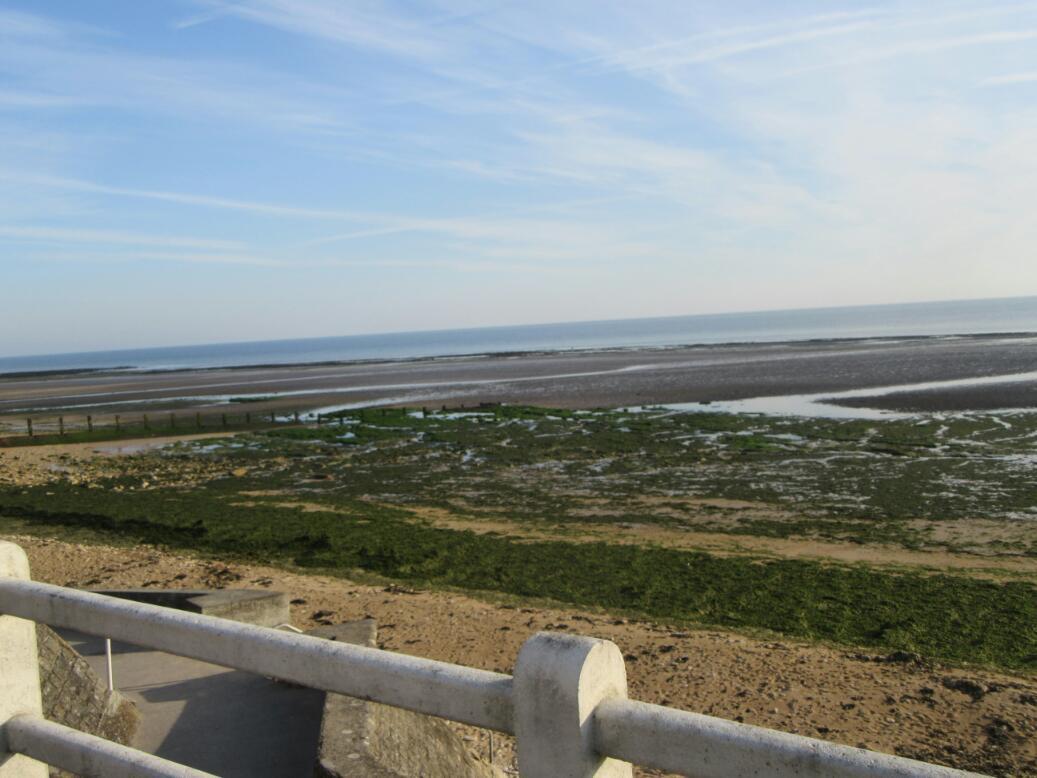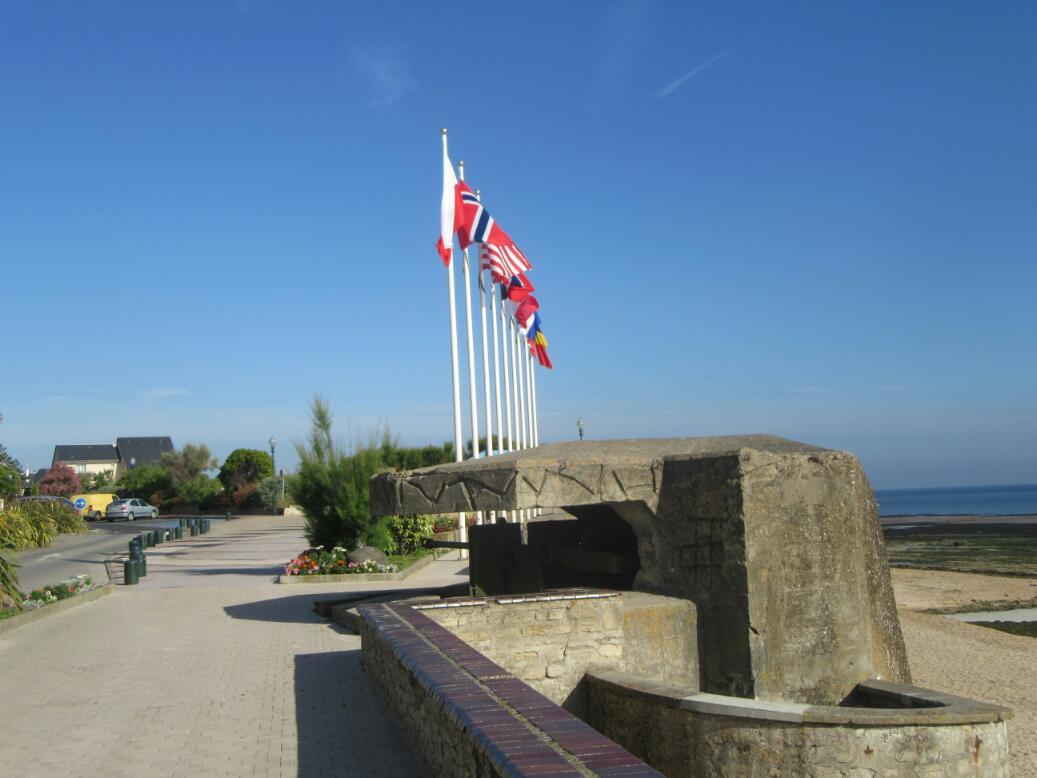June 15, 2017
Day Eighty: Ouistreham to Bayeux
At Ouiestreham you can feel how close England is (without them dropping any landing forces) just by the presence of ferries ready to leave for Portsmouth, and by all the English speaking people around.
Starting from Ouiestreham, we would be riding along side the D Day beaches from east to west. That means we started in the "British Sector", which had British, Canadian, and French forces. The American Sector is further west. The first beach, Sword Beach was British and French, while the next one, Juno Beach, was Canadian.
(The Britsh Sector was somewhat larger than the American, deploying abou 75,000 land forces. The Americans had about 57,000. In addition there were 112,000 British sailors, and 53,000 American. This is just D Day. Half a million or more men went through this area in the months that followed.)
Opposite each of the beaches are the towns that had the fortune/misfortune of being on the front line. Ouiestreham holds down one end of Sword Beach and Lion sur Mer and Luc sur Mer are at the other end of this first beach.
I mention these three towns particularly because they delighted and puzzled us right off the bat. In Ouiestreham, and along the beach by the other two stand
really unique and beautiful houses. They are in the style that we had come to call Belle Epoque, when we saw something like it at Soulac, along the Atlantic coast, north of Rochefort. We had expected that any building in the way of the landing would have been blasted away, so it was strange to see these houses. Could it be that they were all less than 73 years old - that is, postwar construction? Not likely, but I searched their facades for a date. finally I found one - 1889 on a house called "Chalet Henri". That is just the era that made sense, at least style wise.

| Heart | 1 | Comment | 0 | Link |
Thee was further confirmation of the age of the houses when we came to an information panel about how these towns used to be fishing villages. In the background of a photo wth a fishing boat was sure enough one of these houses.

| Heart | 0 | Comment | 0 | Link |

| Heart | 0 | Comment | 0 | Link |
At St. Aubin (where the Canadian - Juno Beach begins) we got something of a comment on the houses, but also a lot more. We had stopped to look at a monument built around a former beach side anti-tank gun, when a man began a conversation with us. The man was "Jacques". At age eighty-two, he was 9 or 10 at the time of D Day. He had lived right here and still does. He saw it happen, and says he later was like a mascot to the Canadians.
Jacques told us a lot of things, and we asked a fair number of questions. Here are some of the things:
The gun has been turned around and arranged for the tourists. In operation it would have more faced the beach, though it could also direct fire inland.
Jacques thinks it looks phoney, all dolled up in fresh paint.
Holes in the stone wall are from Canadian shells.
The flags that we see all around, many on houses, are largely put out because it is June. Jacques favours flags only on public buildings. Further, he said, he remembers and thinks of the Canadians all year long, not only in June.
The houses that we saw have been heavily restored, since they were heavily damaged.
Jacques listed several of the nicknames that people used in referring to the Germans, such as the Bosch. He remembers that his little sister, then 5, referred to them as the 'Mosch".
I was thinking that Jacques is in a unique age category of people old enough that they remember the events of 1944, but not so old that they are actually now dead. Therefore it was a priviledge to meet him. He gave us a goodbye hug and wished us Bonne Route.
The trip down memory lane continued as we came upon a house called Les Hirondelles. (It is the custom to name houses here.) Beside the house stood a plaque with a photo clearly taken from a landing craft, with this very house in front of the debarking soldiers. This kind of thing makes it all seem much more real. We had a similar experience at Checkpoint Charlie in Berlin, where photos of a tank confrontation showed the very buildings were standing beside.

| Heart | 0 | Comment | 0 | Link |

| Heart | 0 | Comment | 0 | Link |

| Heart | 0 | Comment | 0 | Link |

| Heart | 0 | Comment | 0 | Link |

| Heart | 0 | Comment | 0 | Link |
Next, along the beach came marching a group of perhaps 15 strong looking men, all with backpacks. "Where are you going?", I asked one near the lead, in French, But he looked at me and grunted in a way that told me he did not know French. "What are you guys up to?", I asked someone in the next clump. "Just walkin' down the beach" was the reply, in American English. So it's a puzzle.
We arrived at the centre of Juno Beach, opposite the town of Bernieres sur Mer. There is a memorial there, including hard to see map in bronze of the Canadian operations. Several wreaths had been placed, perhaps as part of the not too long ago June 6. One was interesting as it seemed to come from Bernieres Quebec. Bernieres is a small town just south of Quebec City, on the St Lawrence.
Before Courseulles, which marks the other end of Juno Beach there was a sculpture made from 1940's vintage bicycles. A photo showed a section of liaison officers from the 3rd Canadian Infantry Division about to land with their bicycles. I am not sure what a liaison officer does, but clearly a bicycle helps.

| Heart | 0 | Comment | 0 | Link |

We see in the towns here (and throughout the country) the twinning with towns in Germany, Britain, and Canada.
| Heart | 0 | Comment | 0 | Link |

| Heart | 0 | Comment | 0 | Link |
The beaches here naturally have lots of monuments and remembrances, but it is not overwhelming. And there is very little remaining of objects from the era. That means not a lot of bunkers, no sunken ships, few tanks ec. around. What there are a lot of is flags. That's ok, since flags can be meaningful. For example I found it nice to see in a gift shop in Courselles lots of
Canadian and French flags sharing the same display can.
We reached Arromanches, which is at the west end of Gold Beach. The town is down a hill, so as you arrive you get a good overview. It is still a nice looking town, set on a curving bay. Drawing a curved line in the water beyond the town are concrete abutments, which I assume are part of the Mulbury harbour, a temporary harbour set up one here and one in the American sector. The harbours involved a lot of heavy steel and concrete, but I have not been able to visualize what they were like. One of the big pieces of steel rests by the memorial at the top of the hill.
Also up the hill is the 360 degree film presentation building. We sat in its shade to eat lunch and to try to figure out how best to reach our own three objectives - the Bayeux tapestry museum in Bayeux, the Canadian memorial back in Courseulles, and the Arromanches film. We decided to see the film while we were right here. But as we strolled over to the entrance (film to begin in 10 minutes) what turned out to be about 50 teenagers (off tour busses lurking below) flooded in. We said, you know what, we're out of here. So, we missed the film. Had we not, maybe we would know what a Mulbury harbour looked like.

| Heart | 0 | Comment | 0 | Link |

| Heart | 0 | Comment | 0 | Link |
We went down into the town in order to hop on the road to Bayeux. All of the towns along here are famous, but Bayeux is where Charles deGaulle set foot back in France, and gave a speech there
on June 14 after D Day. Two years later in June he gave another speech in which he set out the basic principles that resulted in the current French constitution.
We were surprised when we got in to Bayeux to find it crawling with tourists. The main downtown street was alive with restaurants and such, and we had to use patience to navigate our bikes around. After consulting the TI a bit, we bounced from one downtown hotel to another. The first was cheap, but had no room for bikes. Second and third, too expensive. Now hot, and frazzled, we went into the fourth - pretty darn expensive, but with an easy to access garage and friendly welcome. It is also in the shadow of the rather zippy cathedral, and close to the museum we came here for.
The museum is the one that houses the Bayeux Tapestry. More about that tomorrow.
The hotel reception lady speaks perfect English, but I am insisting on still using French, maybe trying to not admit that our French adventure will end in not that long. She is being very polite about it. In general there is all kinds of english flying around here. I guess the visitors to the beaches are mainly British (though we did observe a German tour group getting a presentation). One bit of fallout is that there is English CNN on the TV and the New York Times available to read. It has been a great vacation here in Europe to not be hearing about Trump. We are going to avoid these media as long as possible.
Today's ride: 50 km (31 miles)
Total: 3,943 km (2,449 miles)
| Rate this entry's writing | Heart | 1 |
| Comment on this entry | Comment | 0 |



















